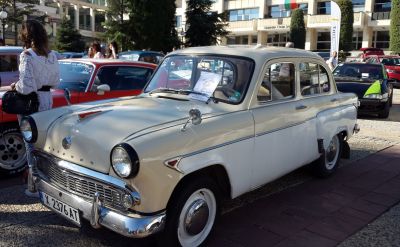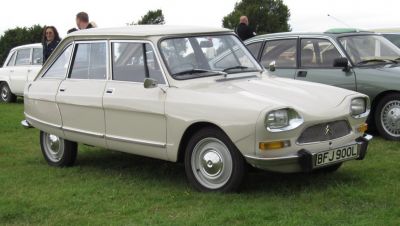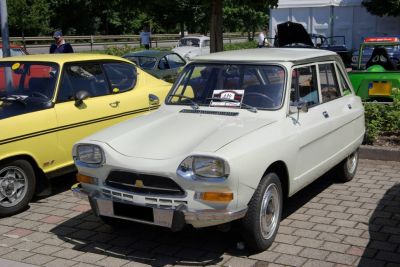 1956 Moskvich 402 Dimensions, Size & Specs
1956 Moskvich 402 Dimensions, Size & Specs
Measurements of the 1956 Moskvich 402, engineered for optimal performance and comfort
| Dimensions | |
|---|---|
| Length: | 4055 mm159.6 in13.3 ft |
| Width: | 1540 mm60.6 in5.1 ft |
| Height: | 1560 mm61.4 in5.1 ft |
| Weight Specifications | |
| Curb Weight: | 900 kg1984 lbs |
| Maximal permitted Weight: | 1280 kg2822 lbs |
| Tire Specifications | |
| Rims Size: | 15-inch rims:
|
| Tire Size: |
|
The Moskvich 402, produced between 1956 and 1958, is a classic Soviet-era compact sedan that stands as a representative of mid-20th-century automotive design. With a length of 4055 millimeters (approximately 159.6 inches), a width of 1540 millimeters (around 60.6 inches), and a height of 1560 millimeters (61.4 inches), this vehicle exhibits the modest and practical dimensions characteristic of its time. Weighing 900 kilograms (about 1984 pounds) curb weight and capable of managing a maximum weight of 1280 kilograms (around 2822 pounds), the Moskvich 402 was engineered for efficiency and durability in everyday driving conditions. Its 4.5K x 15 steel rim wheels, paired with 145/80 R15 tires, contributed to a balanced ride and road handling that met the demands of the era’s road infrastructure. In terms of size, the Moskvich 402's relatively compact dimensions made it suitable for both urban and suburban settings. The vehicle’s overall proportions reflect a straightforward, functional design ethos, common in Soviet automotive engineering during the 1950s. This model holds historical significance as it was among the early post-war civilian vehicles from Moskvich, blending practicality with a modest presence on the road. Enthusiasts and collectors appreciate the Moskvich 402 for its nostalgic value and as an example of practical Soviet sedan design. When compared to other vehicles of its generation, its size and weight positioned it within the compact segment, offering a glimpse into the automotive standards and preferences of the Soviet Union during that period.
Discover the standout features that make the 1956 Moskvich 402 a leader in its class
Have a question? Please check our knowledgebase first.
The Moskvich 402, produced between 1956 and 1958, measures 4055 mm (159.6 inches) in length, 1540 mm (60.6 inches) in width, and 1560 mm (61.4 inches) in height. This compact size made it practical for urban and suburban driving during its era.
The curb weight of the Moskvich 402 is approximately 900 kg (1984 pounds), while the maximum allowable weight is 1280 kg (2822 pounds). This lightweight build was typical for sedans of the 1950s and contributed to the car's fuel efficiency and agility.
Yes, the Moskvich 402 fits comfortably inside a standard garage. Most garages can accommodate vehicles up to about 2.4 meters (approximately 8 feet) wide and 5 meters (16.4 feet) long, and with the Moskvich 402's dimensions of 1.54 meters (5.06 feet) width and 4.06 meters (13.3 feet) length, it has ample clearance for easy parking and maneuvering.
The Moskvich 402's width of 1540 mm (60.6 inches) is narrower than many modern compact sedans, which typically measure around 1750-1800 mm (69-71 inches). This narrower profile reflects design priorities from the 1950s, focusing on smaller footprints for tighter urban spaces.
The Moskvich 402 is equipped with 4.5K x 15 rims paired with 145/80 R15 tires. This combination was common for that period, balancing ride comfort with durability on varying road conditions of the time.
At 1560 mm (61.4 inches) tall, the Moskvich 402 offers a moderately tall cabin height that provides reasonable headroom for passengers. Although its height is greater than many modern low-profile sedans, it was well suited to the boxier, upright car designs of the 1950s, with modest aerodynamic efficiency compared to today's standards.
Compared to the Moskvich 401, the 402 is slightly longer and wider, offering more interior space and a more modern design. While exact measurements of the 401 vary slightly, the 402's dimensions at 4055 mm length and 1540 mm width represented an evolution toward greater comfort and road presence, reflecting post-war automotive trends.
The Moskvich 402 is comparable in size to other mid-1950s compact sedans like the Volkswagen Beetle and the early Hillman Minx, although it generally offers a slightly larger and boxier body style. Its dimensions strike a balance between compactness for urban use and sufficient cabin space, making it competitive in its segment during that era.
The relatively low curb weight of 900 kg (1984 lbs) for the Moskvich 402 can be attributed to its compact dimensions, use of lightweight materials typical of the 1950s, and simple mechanical design. This made the car more fuel efficient and easier to handle, which was advantageous in the post-war Soviet market focusing on affordability and practicality.
Yes, the Moskvich 402's dimensions were very suitable for the road and parking infrastructure of the Soviet Union in the late 1950s. Smaller cars like the 402 could navigate narrow urban streets and fit into limited parking areas more easily than larger vehicles, which was essential in growing cities and towns with limited automotive infrastructure.
Discover similar sized cars.

| Production: | 1958-1963 |
|---|---|
| Model Year: | 1958 |
| Length: | 4055 mm159.6 in |
| Width: | 1540 mm60.6 in |
| Height: | 1560 mm61.4 in |

| Production: | 1969-1973 |
|---|---|
| Model Year: | 1969 |
| Length: | 3990 mm157.1 in |
| Width: | 1520 mm59.8 in |
| Height: | 1485 mm58.5 in |

| Production: | 1973-1976 |
|---|---|
| Model Year: | 1973 |
| Length: | 3990 mm157.1 in |
| Width: | 1520 mm59.8 in |
| Height: | 1485 mm58.5 in |
